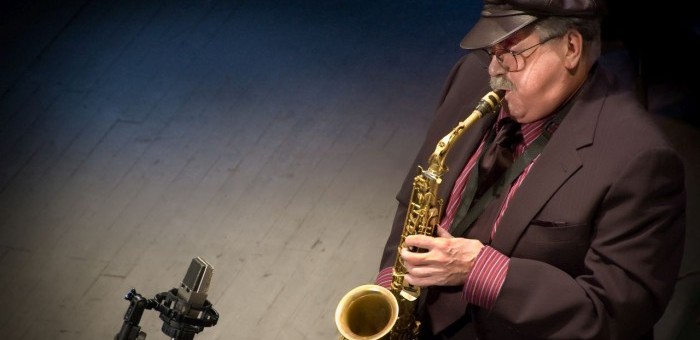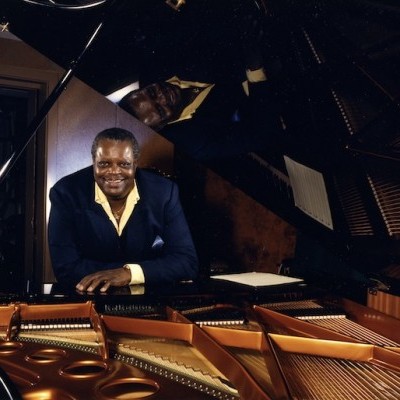Dec 9, 2025 12:28 PM
In Memoriam: Gordon Goodwin, 1954–2025
Gordon Goodwin, an award-winning saxophonist, pianist, bandleader, composer and arranger, died Dec. 8 in Los Angeles.…

Phil Woods (1931–2015) was the subject of tribute concert on Sept. 8.
(Photo: Courtesy philwoods.com)On Sept. 8 in East Stroudsburg, Pennsylvania, three weeks before the first anniversary of Phil Woods’ passing, the non-profit organization Delaware Water Gap Celebration of the Arts (acronym COTA) presented a memorial concert for the magisterial alto saxophonist.
Woods—who lived in nearby New Hope, Pennsylvania, from 1957 to 1968, before moving with his family to France for what would be a four-year stay—co-founded COTA in 1978, two years after he resettled in the Poconos hamlet of Delaware Water Gap with his wife and soul mate, Jill Goodwin.
For the first half of this benefit concert, which preceded COTA’s annual two-day Jazz Festival, Goodwin and her brother, Bill Goodwin—Woods’ drummer of choice after 1975—recruited the personnel of the last edition of the Phil Woods Quintet (Brian Lynch, trumpet; Bill Mays, piano; Steve Gilmore, bass; Goodwin, drums, with alto saxophonist Vincent Herring, a Woods acolyte, assuming Woods’ chair).
Special guests included alto saxophonist Grace Kelly (a Woods protégé who famously collaborated with her hero on a 2011 album), vocalist Bob Dorough, tenor saxophonist Houston Person, trumpeter Randy Brecker and tenor saxophonist Ada Rovatti.
Before the set began, photos of Woods with various elders (Dizzy Gillespie and James Moody), peers (Bobby Hutcherson and Paquito D’Rivera) and acolytes (students at Ramblerny Camp For The Performing Arts, where Woods taught between 1963 to 1967) were projected on a screen on the stage of the Stroudsburg High School auditorium (an excellent acoustical space).
There followed a brief video homage, set to a soundtrack of Woods’ sui generis, haunting instrumental voice playing the Quincy Jones ballad “Quintessence,” during which Woods says, among other things, “Everybody cool? Let’s get immortal.”
The quintet opened with “All Bird’s Children,” the titular track of a 1990 Concord album by the Phil Woods Quintet featuring trombonist Hal Crook as the second horn player. All members soloed fluently on the challenging harmonic structure of this brisk, melody-rich refrain, one of several Woods homages to Charlie Parker. It concluded with a pastiche of juxtaposed licks from the respective corpuses of Parker and Dizzy Gillespie (“Parker’s Mood” and “Dizzy Atmosphere”).
Brecker and Rovatti joined the ensemble for “A Walkin’ Thing,” a Benny Carter tune that first appeared on Carter’s 1958 LP Jazz Giant, and was later recorded by Woods and Carter on their 1996 collaboration, Another Time, Another Place.
The minor key ambiance was an ideal frame for Brecker’s dark tone and Rovatti’s relaxed, legato phrasing, countered by Herring’s turbulent statement, which juxtaposed long cries and Birdlike runs, and Lynch’s formidable declamation. Mays had fun with a long, tumbling section, then counteracted with a sequence of immaculately executed sixteenth notes.
Person joined the trio for a characteristically pithy, medium-bounce reading of “The Very Thought Of You,” complemented by Mays’ impeccable comping and just-dissonant-enough solo. Dorough, an area resident since 1970, presented his lyrics to Woods’ “Johnny Hodges,” which debuted on the 1988 album, Phil Woods With The Tommy Flanagan Trio.
Dorough’s interpretation included state-of-the-art scat singing, a couplet citing “the Rabbit, my first habit,” and a section quoting “A Flower Is A Lovesome Thing.” Then, joined by Kelly, Dorough sang his lyrics to the young altoist’s “The Man With The Hat” (a reference to Woods bestowing upon Kelly his trademark cap).
All members came on board for a rousing, ebullient romp through Oscar Pettiford’s “Bohemia After Dark,” which Woods first heard in 1955, when Cannonball Adderley played it with the composer at his New York debut at the Café Bohemia in Greenwich Village, around the corner from the Nut Club, a strip joint where Woods had a steady sinecure in the house band.
The second set featured a series of Woods’ composition-arrangements performed by the Phil Woods Big Band, a cohesive17-piece unit comprised of top-shelf musicians who live in the Poconos. Among them were saxophonists Nelson Hill and Tom Hamilton, who both played on Woods’ 1997 orchestral recording 1997 Celebration!, from which most of the repertoire was culled. The other pieces are documented on the 2013 album New Celebration, on which most of the evening’s personnel had participated.
The crisp, optimistic “Reet’s Neet”—which Woods recorded three times in small group contexts during the early 1980s, and subsequently on Celebration!—would have fit right into the Count Basie book when Quincy Jones was writing regularly for them.
Alto saxophonist Matt Vashlishian, a 30-something one-time Woods’ student (and an alumnus of Stroudsburg High School) who served as efficient band director and polished emcee during the set, soloed with aplomb, followed by meaningful statements from lead trumpeter Nathan Eklund, pianist Skip Williams, tenor saxophonist Tom Hamilton and bassist Evan Gregor.
Kelly and Lynch (who offered a pithy, beautifully organized statement) were the soloists on “My Man Benny,” a mellow Woods homage to Carter that titled (and debuted on) on their 1990 meeting, My Man Benny, My Man Phil. After Williams’ notey solo, the band executed a well-wrought penultimate soli passage.
Brecker and Rovatti returned for “Goodbye Mr. Pepper,” a bossa from New Celebration that featured compelling brass section writing, with particularly evocative colors from the trombones, which complemented Brecker’s elegant, deliberate, lyric solo.
“Get Bird’s Word,” a stomper from that same album, featured “dueling” altos—Nelson Hill’s solo was fleet, with barline-crossing phrases; Kelly’s was a model of thematic organization; Herring’s launched from a two-note opening into soaring, swooping lines—before transitioning to a driving, immaculately executed saxophone soli passage by the orchestra.
Person and Wilkins performed as a duo on a verse-like passage on Tadd Dameron’s “If You Could See Me Now,” before the orchestra stated the iconic melody. Person cut directly to the chase with conversational, voice-like tone and minimal embellishment, bittersweet but no bathos, then concluded with a slightly re-harmonized summation of the theme.
The penultimate selection, “Before I Left”—from Woods’ 1998 Blue Note meeting with Johnny Griffin, The Rev And I—was a stomping, Gillespie-esque contrafact of “After You’ve Gone,” with a tenor saxophone solo by David Dempsey, another flawless trumpet solo by Lynch, a swinging solo by guitarist Spencer Reed, and a baritone sax solo by Jay Rattman.
All hands came on deck to conclude the successful voyage with “How’s Your Mama,” another bebop-referential line, full of Woodsian in-jokes and montage, that the master had deployed as his own set-closer since the ’70s.

Goodwin was one of the most acclaimed, successful and influential jazz musicians of his generation.
Dec 9, 2025 12:28 PM
Gordon Goodwin, an award-winning saxophonist, pianist, bandleader, composer and arranger, died Dec. 8 in Los Angeles.…

Nov 13, 2025 10:00 AM
For results of DownBeat’s 90th Annual Readers Poll, complete with feature articles from our December 2025 issue,…

Flea has returned to his first instrument — the trumpet — and assembled a dream band of jazz musicians to record a new album.
Dec 2, 2025 2:01 AM
After a nearly five-decade career as one of his generation’s defining rock bassists, Flea has returned to his first…

To see the complete list of nominations for the 2026 Grammy Awards, go to grammy.com.
Nov 11, 2025 12:35 PM
The nominations for the 2026 Grammy Awards are in, with plenty to smile about for the worlds of jazz, blues and beyond.…

“It’s a pleasure and an honor to interpret the music of Oscar Peterson in his native city,” said Jim Doxas in regard to celebrating the Canadian legend. “He traveled the world, but never forgot Montreal.”
Nov 18, 2025 12:16 PM
In the pantheon of jazz luminaries, few shine as brightly, or swing as hard, as Oscar Peterson. A century ago, a…